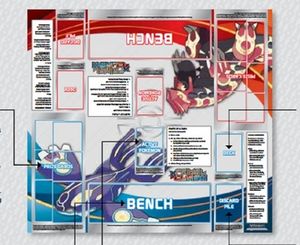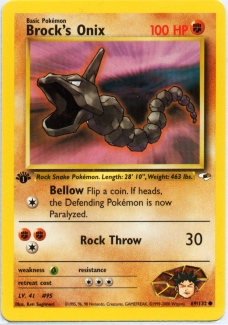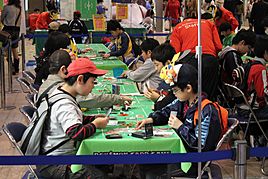Pokémon Trading Card Game facts for kids
| Designer |
|
|---|---|
| Publisher | The Pokémon Company Japan Media Factory (October 1996 – November 2000) United States Wizards of the Coast (December 1998 – July 2003) |
| Release date | October 20, 1996 |
| Type | Collectible |
| Players | 2 |
| Skills required | Card playing Arithmetic Reading |
| Age range | 6+ |
| Playing time | 2–120 minutes |
| Random chance | Some (order of cards drawn, dice, coin flip) |
The Pokémon Trading Card Game (often called Pokémon TCG) is a fun collectible card game. It's based on the popular Pokémon video games and TV shows. Creatures Inc. developed the game. It first came out in Japan in October 1996. Later, Wizards of the Coast published it in the US. Now, The Pokémon Company handles publishing worldwide. By March 2023, over 52.9 billion cards had been sold!
Contents
How to Play the Pokémon TCG
The Pokémon Trading Card Game is a strategy game for two players. You play as a Pokémon Trainer. Your goal is to use your Pokémon to battle your opponent's Pokémon.
Each player starts with one Pokémon as their Active Pokémon. This Pokémon is the one that battles. When a Pokémon takes too much damage, it gets "Knocked Out." This means it's out of the game. When you Knock Out an opponent's Pokémon, you get to take a "Prize card." Prize cards are a key way to win. If you collect six Prize cards, you win the game instantly!
You can also win if your opponent runs out of Pokémon on their "Bench." The Bench is where you keep up to five extra Pokémon ready to battle. Another way to win is if your opponent can't draw a card at the start of their turn.
Starting a Game
To begin, one player flips a coin. The winner decides who goes first. (Sometimes, dice are used instead of coins, especially in official tournaments.) The player who goes first cannot attack or play a Supporter card on their first turn.
Both players shuffle their decks. Then, they each draw seven cards. Next, each player puts one Basic Pokémon face down as their Active Pokémon. If you don't have a Basic Pokémon, you have to shuffle your hand back into your deck and draw a new one. This is called a "mulligan." Your opponent gets to draw an extra card for each mulligan you take.
Once both players have an Active Pokémon, they can put up to five more Basic Pokémon on their Bench. Finally, each player takes the top six cards from their deck and places them face down as their Prize cards.
What You Do on Your Turn
Players take turns doing several actions. During your turn, you can:
- Play more Basic Pokémon onto your Bench.
- Evolve your Pokémon (make them stronger).
- Play Trainer cards (like Item, Supporter, Stadium, or Pokémon Tool cards).
- Attach one Energy card to one of your Pokémon.
- Use Pokémon Abilities.
- Attack with your Active Pokémon.
You can also "retreat" your Active Pokémon. This means you switch it with a Pokémon from your Bench. You usually have to pay an Energy cost to retreat.
At the end of your turn, you can use one of your Active Pokémon's attacks. Your Pokémon needs the right amount and type of Energy attached to it to attack. Attacks deal damage to your opponent's Active Pokémon. Some attacks also have special effects. Pokémon can have "weaknesses" or "resistances" to certain types, which changes how much damage they take. If you Knock Out an opponent's Pokémon, you take a Prize card before your turn ends.
Types of Cards
There are three main types of cards in the Pokémon TCG: Pokémon, Energy, and Trainer cards.
Pokémon Cards
Pokémon cards show different Pokémon from the video games. They have a name, an elemental type, attacks, Abilities, and HP (Hit Points).
- Basic Pokémon are Pokémon that haven't evolved. You can play them directly onto your Bench. You can have up to six Pokémon in play: one Active and five on the Bench.
- Evolution Pokémon are stronger versions of Pokémon. They can't be played directly. You have to place them on top of a Basic Pokémon or a Stage 1 Pokémon to evolve it.
- Stage 1 Pokémon evolve from Basic Pokémon.
- Stage 2 Pokémon evolve from Stage 1 Pokémon.
- When a Pokémon evolves, it usually gets more HP and stronger attacks.
- Pokémon ex cards (from 2003) and Pokémon V cards (from 2020) are powerful. When they are Knocked Out, your opponent takes two Prize cards instead of one.
- Pokémon VMAX cards (from 2020) are even stronger. When they are Knocked Out, your opponent takes three Prize cards!
- Pokémon GX cards (from 2016) have a special "GX attack" that you can only use once per game.
- V-Union cards (from 2021) are made from four separate cards that combine into one super-powerful Pokémon. They give three Prize cards when Knocked Out.
- VSTAR cards (from 2022) are another evolution of Pokémon V. They have special "VSTAR Powers" that you can use once per game.
- Radiant Pokémon (from 2022) are special cards. You can only have one Radiant Pokémon in your whole deck.
- Tera Pokémon ex (from 2023) have unusual types and can't be attacked while on the Bench.
Most Pokémon attacks need Energy to be used. Abilities are special effects that you can use during your turn. They don't require Energy and stay active as long as the Pokémon is in play.
Energy Cards
Energy cards power your Pokémon's attacks. You can only attach one Energy card per turn. There are two types:
- Basic Energy cards are the most common. There are nine types: Grass, Fire, Water, Lightning, Psychic, Fighting, Darkness, Metal, and Fairy. Dragon-type Pokémon use multiple types of Energy. Basic Energy cards simply provide the Energy needed for attacks or retreating.
- Special Energy cards have extra effects besides providing Energy.
If an attack needs "Colorless Energy," you can use any type of Energy card to meet that cost.
Trainer Cards
Trainer cards help you in different ways. They can heal your Pokémon, make your opponent discard cards, or let you get cards back from your discard pile. Trainer cards are divided into categories:
- Item cards directly affect the battling Pokémon. You can play as many Item cards as you want on your turn.
- Pokémon Tool cards are attached to a Pokémon and change its features.
- Stadium cards stay in play and affect both players.
- Supporter cards have strong effects, but you can only play one Supporter card per turn.
Pokémon Types and Weaknesses
| TCG type | Game type |
|---|---|
| Grass | Grass and Bug, Poison (1996-2019) |
| Fire | Fire |
| Water | Water and Ice |
| Lightning | Electric |
| Psychic | Psychic, Poison (1996-2019), Fairy (2019-) and Ghost |
| Fighting | Fighting, Rock and Ground |
| Darkness | Dark and Poison (2019-) |
| Metal | Steel |
| Dragon | Dragon (2012-2019, 2021-) |
| Fairy | Fairy (2014-2019) |
| Colorless | Normal, Dragon (1996-2012) and Flying |
Pokémon Types are like elemental powers. They decide how much damage a Pokémon takes or deals. If a Pokémon is "weak" to an attack's type, it takes double damage! If it "resists" a type, it takes less damage. This creates a "rock-paper-scissors" style of play.
The Pokémon TCG has types like Fire, Fighting, Dragon, Lightning, Grass, Water, Fairy, Psychic, Darkness, Metal, and Colorless. Some types from the video games, like Ice or Ground, are grouped under other types in the card game. For example, Ice-type Pokémon are usually Water-type in the TCG.
Card Sets and Expansions
The Pokémon TCG started in Japan in 1996 with the "1st Starter & Expansion Pack." This set came out in the United States in 1999. It featured the original 150 Pokémon.
In the US, the first sets were published by Wizards of the Coast. These included "Base Set," "Jungle," "Fossil," and "Team Rocket." Later, The Pokémon Company took over publishing in 2003. Since then, many more "Generation" sets have been released, bringing new Pokémon and game mechanics.
The Pokémon TCG: Scarlet & Violet set, released in 2023, is one of the newest expansions. Each new set adds more cards and keeps the game exciting!
Collecting Pokémon Cards
You can buy Pokémon cards in many ways. They come in pre-made decks, booster packs (small packs of cards), or large booster boxes. You can also find them online. But always be careful of fake cards!
Pokémon cards have different values based on how rare they are. Sometimes, a less rare card can be worth a lot if it's popular in competitive play, very old, or if not many were printed.
You can tell a card's rarity by the symbol in its bottom corner:
- Circle means Common (easiest to find).
- Diamond means Uncommon.
- Star means Rare (harder to find).
In Japanese cards, letters are used instead of shapes (C, U, R, RR, SR, UR).
A typical Pokémon TCG booster pack usually has 10 cards. You might get five Common cards, three Uncommon cards, a "reverse holographic" card (shiny everywhere but the picture), and sometimes a Rare card. Newer packs, like those from the Scarlet and Violet series, guarantee one holographic card and two reverse holographic cards.
Beyond the basic rarities, there are many special types of rare cards:
- Holo Rare cards have a shiny, holographic picture.
- Reverse Holo cards are shiny everywhere except the picture.
- Half Art and Full Art cards have artwork that covers half or all of the card.
- Secret Rare cards are super rare versions of Full Art or Half Art cards. They often have special shiny patterns or gold borders. They have a set number that goes beyond the normal set size (like 242/220).
- Rainbow Rare cards are a type of Secret Rare with a rainbow-colored shine.
Some of the oldest cards, like "1st-edition Base Set" cards, are very rare and can be worth thousands or even millions of dollars! Collectors often use protective sleeves to keep their valuable cards safe.
The "Pikachu Illustrator" card is the rarest and most expensive Pokémon card ever sold. In 2021, a celebrity collector bought one for over $5 million! Only 41 copies were ever made. They were given as prizes in a Pokémon design contest in Japan. This card is special because it says "Illustrator" instead of "Trainer." Atsuko Nishida, who designed Pikachu, illustrated it.
Competitive Play
Many players enjoy battling others in Pokémon TCG tournaments. The Pokémon Company International runs a program called Play! Pokémon. In these events, players can earn points, special promo cards, badges, and other prizes.
Tournaments have different age groups:
- Junior (10 years old and younger)
- Senior (11 to 14 years old)
- Master (15 years old and older)
In most tournaments, players play several rounds against others with similar win/loss records. The best players then move on to a single-elimination bracket until a winner is found.
There are many levels of tournaments, from local events to huge championships. The biggest event is the Pokémon World Championships, which is invite-only. Players can earn an invitation by doing well in other major tournaments. The winner of the Masters Division at Worlds is often seen as the best player in the world for that year!
Super Trainer Showdowns
Before the World Championships, there were events called "Super Trainer Showdowns." These were big Pokémon TCG tournaments held in the United States by the original publisher, Wizards of the Coast, in 2000 and 2001. They also had three age groups. Players could win trips to these showdowns by doing well in smaller "Qualifier Tournaments."
The first Super Trainer Showdown was held on a cruise ship in Long Beach, California, in July 2000. Over 1,600 players attended the third Showdown in New Jersey in June 2001!
Pokémon TCG Video Games
The Pokémon Trading Card Game got its own video game! It was developed by Hudson Soft and Creatures and published by Nintendo for the Game Boy Color. It came out in Japan in 1998 and in North America and Europe in 2000. This game let you play the TCG on your Game Boy, with 226 cards from the real game.
Later, the Pokémon Trading Card Game Online was released in 2011. This digital version lets you play the Pokémon TCG on computers, phones, and tablets. You can even redeem codes from real booster packs to get digital cards!
In 2021, a new game called Pokémon Trading Card Game Live was announced. It started a beta test in 2022 and will eventually replace Pokémon Trading Card Game Online. Existing players can transfer their accounts and cards to the new game.
See also
 In Spanish: Juego de cartas coleccionables Pokémon para niños
In Spanish: Juego de cartas coleccionables Pokémon para niños





